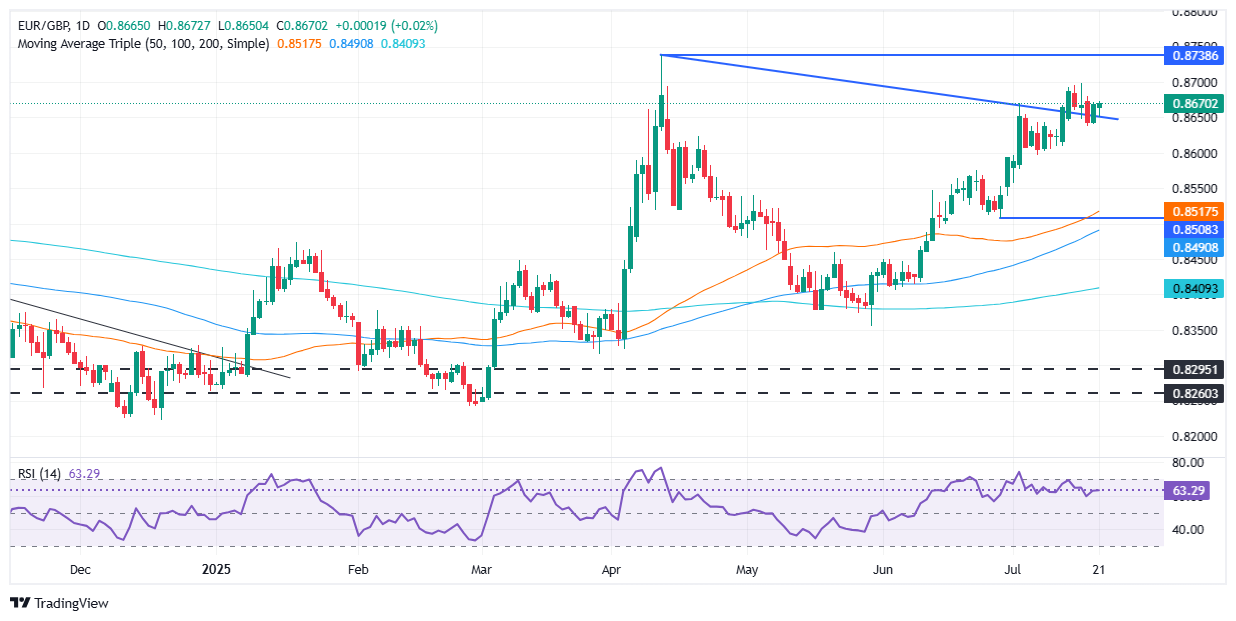- The ECB is expected to maintain stable rates this week, with a 38% probability of a cut.
- The United Kingdom inflation reaches a maximum of 1 year, but the BOE is still expected to reduce at 25 basic points in August.
- The EU prepares a reprisal plan while commercial tensions with the US threaten to climb.
The common currency remains stable in front of the sterling pound on Monday, before a week occupied while the operators expect the monetary policy decision of the European Central Bank (ECB) and a speech by the Governor of the Bank of England (BOE), Andrew Bailey. At the time of writing, the pair is negotiated at 0.8670, practically unchanged.
The common currency awaits the decision of the ECB and the Bailey speech; Betting features in the United Kingdom increases despite the jump in inflation
This week, the ECB is expected to keep the rates without changes, according to the probabilities of interest rates, which show a 62% probability. The probabilities of a rate cut are in 38%, according to Prime Market Terminal data.
Commercial news revealed that EU envieves are ready to meet as soon as this week to formalize a reprisal plan in case of a possible scenario of not agreement with the US president, Trump, according to Bloomberg.
Last week, the economic data of the United Kingdom were mixed, with a cooling labor market, but inflation unexpectedly rose to its highest level in more than a year. Despite these contrasts, the money market awaits a 25 basic points cut (PBS) by the BOE at the meeting of August 7, followed by 50 PBs of relief towards the end of the year.
Goldman Sachs analysts revealed: “We believe that an increase in fiscal risk premium is the main engine of the recent higher performance of the EUR/GBP.”
The fiscal position of the United Kingdom is risky after Parliament caused a change of course in well -being reforms, increasing doubts about the government’s ability to reduce spending. After that, most economists suggest that the government needs to increase taxes to meet their tax rules and achieve their growth objectives.
EUR/GBP prices forecast: technical forecast
The EUR/GBP remains consolidated, although the rupture of a line of resistance trend drawn from the peak of the current year of 0.8738 that passes about 0.8650 was decisively broken, clearing the way for greater rise. The relative force index (RSI) indicates that the impulse remains bullish, despite the fact that the slope has become flat.
For an upward continuation, operators need to exceed the figure of 0.8700 to be able to challenge the maximum of the year to date (YTD) of 0.8738. A rupture of this last will expose 0.8750 and 0.8800. On the other hand, if the EUR/GBP falls below 0.8650, a decrease towards the 20 -day SMA is expected at 0.8617, followed by a possible fall to 0.8600.

EURO – FREQUENT QUESTIONS
The euro is the currency of the 19 countries of the European Union that belong to the Eurozone. It is the second most negotiated currency in the world, behind the US dollar. In 2022, it represented 31 % of all foreign exchange transactions, with an average daily business volume of more than 2.2 billion dollars a day. The EUR/USD is the most negotiated currency pair in the world, with an estimate of 30 %of all transactions, followed by the EUR/JPY (4 %), the EUR/GBP (3 %) and the EUR/AU (2 %).
The European Central Bank (ECB), based in Frankfurt (Germany), is the Eurozone reserve bank. The ECB establishes interest rates and manages monetary policy. The main mandate of the ECB is to maintain price stability, which means controlling inflation or stimulating growth. Its main tool is the rise or decrease in interest rates. Relatively high interest rates (or the expectation of higher types) usually benefit the euro and vice versa. The GOVERNMENT BOOK of the ECB makes decisions about monetary policy in meetings that are held eight times a year. The decisions are made by the directors of the National Banks of the Eurozone and six permanent members, including the president of the ECB, Christine Lagarde.
Eurozone inflation data, measured by the harmonized consumer prices index (IPCA), are an important economic indicator for the euro. If inflation increases more than expected, especially if it exceeds 2% of the ECB, it forces the ECB to rise interest rates to control it again. Relatively high interest rates compared to their counterparts usually benefit the euro, since they make the region more attractive as a place for global investors to deposit their money.
Published data measure the health of the economy and can have an impact on the euro. Indicators such as GDP, manufacturing and services PMIs, employment and consumer trust surveys can influence the direction of the single currency. A strong economy is good for the euro. Not only attracts more foreign investment, but it can encourage the ECB to raise interest rates, which will directly strengthen the euro. Otherwise, if economic data is weak, the euro is likely to fall. The economic data of the four largest economies in the euro zone (Germany, France, Italy and Spain) are especially significant, since they represent 75% of the economy of the euro area.
Another important fact that is published on the euro is the commercial balance. This indicator measures the difference between what a country earns with its exports and what you spend on imports during a given period. If a country produces highly demanded export products, its currency will gain value simply by the additional demand created by foreign buyers seeking to buy those goods. Therefore, a positive net trade balance strengthens a currency and vice versa in the case of a negative balance
Source: Fx Street
I am Joshua Winder, a senior-level journalist and editor at World Stock Market. I specialize in covering news related to the stock market and economic trends. With more than 8 years of experience in this field, I have become an expert in financial reporting.







